 Many kids take naturally to computers and educators want to make sure they become computer literate to succeed in the 21st Century. But while those computers are stimulating young minds, what are they doing to young bodies?
Many kids take naturally to computers and educators want to make sure they become computer literate to succeed in the 21st Century. But while those computers are stimulating young minds, what are they doing to young bodies?
Most computers used by children in the home and at school are not being used on proper workstations. Children will be using computers all their lives and must be taught how to use them safely and avoid problems now and in the future.
Television media reported last month that the use of computers by children, from grade school ages and older, is creating an early onset of health problems. More and more cases of neck, shoulder, and back pain are being reported in young children as well as repetitive strain injuries commonly seen in adults. A major contributor being the use of computers, and not to mention video games.
As adults we spend hours upon hours in front of the computer screen and at the end of the day we are complaining of tension and pain in the neck, and shoulders. We already know that this repetitive, continuous activity can lead to postural and muscular imbalances. What takes us hours to experience these problems takes children minutes. Even one hour, on a regular basis, in front of the computer for a child manifests the same results. Children may not complain of stiffness or limited range of motion, instead they may complain of headaches, difficulty sleeping, and neck pain. This problem among our children is largely going unnoticed. If we continue to ignore it we will be seeing an increase in health problems in young adults. At present rates, today’s children will spend more than two years during their lifetimes on e-mail and more than 23 years on the Internet. Why wait until your children develop these painful symptoms, when we can be pro-active today and take steps to prevent these potential problems from occurring.
What can you do? Monitor your children’s use of the computer. Make sure they use them over small intervals, and that they take frequent breaks. Monitor their posture while at the computer. Knees and elbows should be kept at an angle of 90 degrees or greater.  They should have good back support, the feet should be flat on the floor or on a footrest. The wrists should be in a flat neutral position while typing. Have them sit at a safe distance away from the computer screen (approx. 20 inches). Speak to the schools and encourage them to prepare proper ergonomic workstations for the students. Many educators are unaware of the impact this is having on children’s spines. Proper stretching techniques for the neck, shoulder, and back muscles on a regular basis, especially during and after using the computer can help combat the strain. Regular check-ups with the chiropractor and massage therapist will help to correct any postural and muscular imbalances, which develop as a direct result of computer use.
They should have good back support, the feet should be flat on the floor or on a footrest. The wrists should be in a flat neutral position while typing. Have them sit at a safe distance away from the computer screen (approx. 20 inches). Speak to the schools and encourage them to prepare proper ergonomic workstations for the students. Many educators are unaware of the impact this is having on children’s spines. Proper stretching techniques for the neck, shoulder, and back muscles on a regular basis, especially during and after using the computer can help combat the strain. Regular check-ups with the chiropractor and massage therapist will help to correct any postural and muscular imbalances, which develop as a direct result of computer use.
As technology continues to develop toward the computer and digital realm, this problem is only going to grow. We have the opportunity and knowledge today to take the appropriate action steps and give our children the care they need – the care that was unavailable to us as children.
 how much weight you have to lift to clear your sidewalk or driveway — on average, several hundred pounds!
how much weight you have to lift to clear your sidewalk or driveway — on average, several hundred pounds! If you find you have to lift a shovelful of snow, use your knees and your leg and arm muscles to do the pushing and lifting, while
If you find you have to lift a shovelful of snow, use your knees and your leg and arm muscles to do the pushing and lifting, while approximately 1 in 3 persons will be 65 or older. At age 65 the average man will live an additional 14.5 years and the average woman an additional 18.6 years.
approximately 1 in 3 persons will be 65 or older. At age 65 the average man will live an additional 14.5 years and the average woman an additional 18.6 years. they can provide about your daily aches and pains. Your feet are first in line in the chain of responsibility of trying to balance your body weight. Second is the leg muscles, third the knees, fourth the hips, and finally the spine. Each have their share in the responsibility, but if the chain is broken at the bottom, then that alters everything above.
they can provide about your daily aches and pains. Your feet are first in line in the chain of responsibility of trying to balance your body weight. Second is the leg muscles, third the knees, fourth the hips, and finally the spine. Each have their share in the responsibility, but if the chain is broken at the bottom, then that alters everything above. Check for calluses (under the second toe, baby toe). Check for dry and cracking heels. Check the soles of your shoes for wear-and-tear on the heels (often you will find one side wears down a lot faster). Check the arches of your feet by rolling your foot over a tennis ball or soup can. Are there areas of pain?
Check for calluses (under the second toe, baby toe). Check for dry and cracking heels. Check the soles of your shoes for wear-and-tear on the heels (often you will find one side wears down a lot faster). Check the arches of your feet by rolling your foot over a tennis ball or soup can. Are there areas of pain?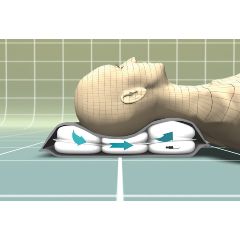 Support your head at the proper height whether you’re sleeping on your side or on your back. A good way to check your alignment is to make sure your nose is in line with your sternum (the little divot or notch between your collar bones)
Support your head at the proper height whether you’re sleeping on your side or on your back. A good way to check your alignment is to make sure your nose is in line with your sternum (the little divot or notch between your collar bones) head and keeps your spine in alignment. Usually a good supportive pillow has a curved edge that can sit between your ear and your shoulder when on your side. Memory foam pillows can be manipulated to fill in the space between you head and neck. Have your chiropractor check your current pillow to see if it is correct for you. A small change in your pillow can make all the difference for a better sleep and less discomfort. Your spine will thank you for it!
head and keeps your spine in alignment. Usually a good supportive pillow has a curved edge that can sit between your ear and your shoulder when on your side. Memory foam pillows can be manipulated to fill in the space between you head and neck. Have your chiropractor check your current pillow to see if it is correct for you. A small change in your pillow can make all the difference for a better sleep and less discomfort. Your spine will thank you for it!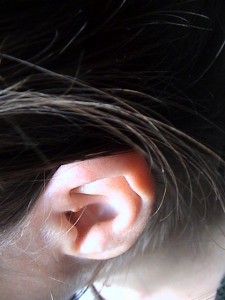 children regularly get colds or ear infections? Studies show that by the age of two approximately 66% of children have had at least one episode of a middle ear infection, also known as otitis media (OM). OM is the leading reason for visitation to the pediatrician’s office. The traditional medical treatment for OM includes the use of antibiotic therapy and/or surgery to place tubes in the ear with only limited success in stopping the recurrence of the problem. A recent trend which is even more frightening is the increase in children who have been recommended that they maintain a low dose of antibiotics for months after no signs of OM are present. With this direction, why should it surprise us that we face an epidemic of bacteria resistance, leaving an alarming number of drugs on the market ineffectual when really needed.
children regularly get colds or ear infections? Studies show that by the age of two approximately 66% of children have had at least one episode of a middle ear infection, also known as otitis media (OM). OM is the leading reason for visitation to the pediatrician’s office. The traditional medical treatment for OM includes the use of antibiotic therapy and/or surgery to place tubes in the ear with only limited success in stopping the recurrence of the problem. A recent trend which is even more frightening is the increase in children who have been recommended that they maintain a low dose of antibiotics for months after no signs of OM are present. With this direction, why should it surprise us that we face an epidemic of bacteria resistance, leaving an alarming number of drugs on the market ineffectual when really needed. A common question we are asked is how does a child can get these subluxations. The first source of subluxation is the birth process itself. Although a baby’s spine and neck are supple, they are also very vulnerable to subluxation because they have no muscular development to support the spine. A tremendous amount of force goes through a baby’s spine during an uncomplicated birth. Other stresses after birth including, crawling, learning to walk, bumps and falls can compound the problem.
A common question we are asked is how does a child can get these subluxations. The first source of subluxation is the birth process itself. Although a baby’s spine and neck are supple, they are also very vulnerable to subluxation because they have no muscular development to support the spine. A tremendous amount of force goes through a baby’s spine during an uncomplicated birth. Other stresses after birth including, crawling, learning to walk, bumps and falls can compound the problem. Many kids take naturally to computers and educators want to make sure they become computer literate to succeed in the 21st Century. But while those computers are stimulating young minds, what are they doing to young bodies?
Many kids take naturally to computers and educators want to make sure they become computer literate to succeed in the 21st Century. But while those computers are stimulating young minds, what are they doing to young bodies? They should have good back support, the feet should be flat on the floor or on a footrest. The wrists should be in a flat neutral position while typing. Have them sit at a safe distance away from the computer screen (approx. 20 inches). Speak to the schools and encourage them to prepare proper ergonomic workstations for the students. Many educators are unaware of the impact this is having on children’s spines. Proper stretching techniques for the neck, shoulder, and back muscles on a regular basis, especially during and after using the computer can help combat the strain. Regular check-ups with the chiropractor and massage therapist will help to correct any postural and muscular imbalances, which develop as a direct result of computer use.
They should have good back support, the feet should be flat on the floor or on a footrest. The wrists should be in a flat neutral position while typing. Have them sit at a safe distance away from the computer screen (approx. 20 inches). Speak to the schools and encourage them to prepare proper ergonomic workstations for the students. Many educators are unaware of the impact this is having on children’s spines. Proper stretching techniques for the neck, shoulder, and back muscles on a regular basis, especially during and after using the computer can help combat the strain. Regular check-ups with the chiropractor and massage therapist will help to correct any postural and muscular imbalances, which develop as a direct result of computer use. With summer finally here millions of individuals are dusting off their golf clubs and hitting the driving range or golf course. Unfortunately, a significant percentage will suffer needlessly with back pain, which is the most common problem among golfers.
With summer finally here millions of individuals are dusting off their golf clubs and hitting the driving range or golf course. Unfortunately, a significant percentage will suffer needlessly with back pain, which is the most common problem among golfers.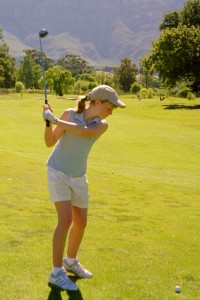 Lets look at the golf swing in more detail. The swing is performed by coiling the upper body on the back swing against the resistance of the lower body before being unleashed. This means powerful muscles twist and pull at the lumbar spine. Due to bad posture, poor back and abdominal toning and inflexibility, the discs of the spine may be squeezed during the swing and lower back problems may result. A large myth associated with the golf swing involves the notion that the club speed at ball impact is dependent on maximum spinal rotation during the back swing. Many instructors advocate this theory and recommend golfers keep their pelvis as stationary as possible, while the spine is maximally rotated. These swing positions are popular because it is believed that maximal spinal rotation somehow engages the “big” muscles of the back, allowing for a sling shot effect during the downswing. As a chiropractor I find this theory interesting because there are no known back muscles that require spinal rotation to become engagaed. This “big muscle” theory is flawed. Maximal spinal rotation doesn’t engage the spinal muscles or the other muscles required to generate power in the golf swing, such as the latissimus dorsi (a.k.a. the lats), pectoralis major and the muscles of the arm and forearm.
Lets look at the golf swing in more detail. The swing is performed by coiling the upper body on the back swing against the resistance of the lower body before being unleashed. This means powerful muscles twist and pull at the lumbar spine. Due to bad posture, poor back and abdominal toning and inflexibility, the discs of the spine may be squeezed during the swing and lower back problems may result. A large myth associated with the golf swing involves the notion that the club speed at ball impact is dependent on maximum spinal rotation during the back swing. Many instructors advocate this theory and recommend golfers keep their pelvis as stationary as possible, while the spine is maximally rotated. These swing positions are popular because it is believed that maximal spinal rotation somehow engages the “big” muscles of the back, allowing for a sling shot effect during the downswing. As a chiropractor I find this theory interesting because there are no known back muscles that require spinal rotation to become engagaed. This “big muscle” theory is flawed. Maximal spinal rotation doesn’t engage the spinal muscles or the other muscles required to generate power in the golf swing, such as the latissimus dorsi (a.k.a. the lats), pectoralis major and the muscles of the arm and forearm.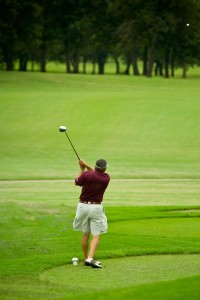
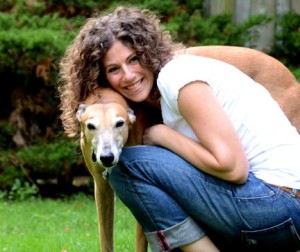 Why would an animal need to see a chiropractor? I get asked this question almost every time someone hears I’m a chiropractor for both animals and people.
Why would an animal need to see a chiropractor? I get asked this question almost every time someone hears I’m a chiropractor for both animals and people.